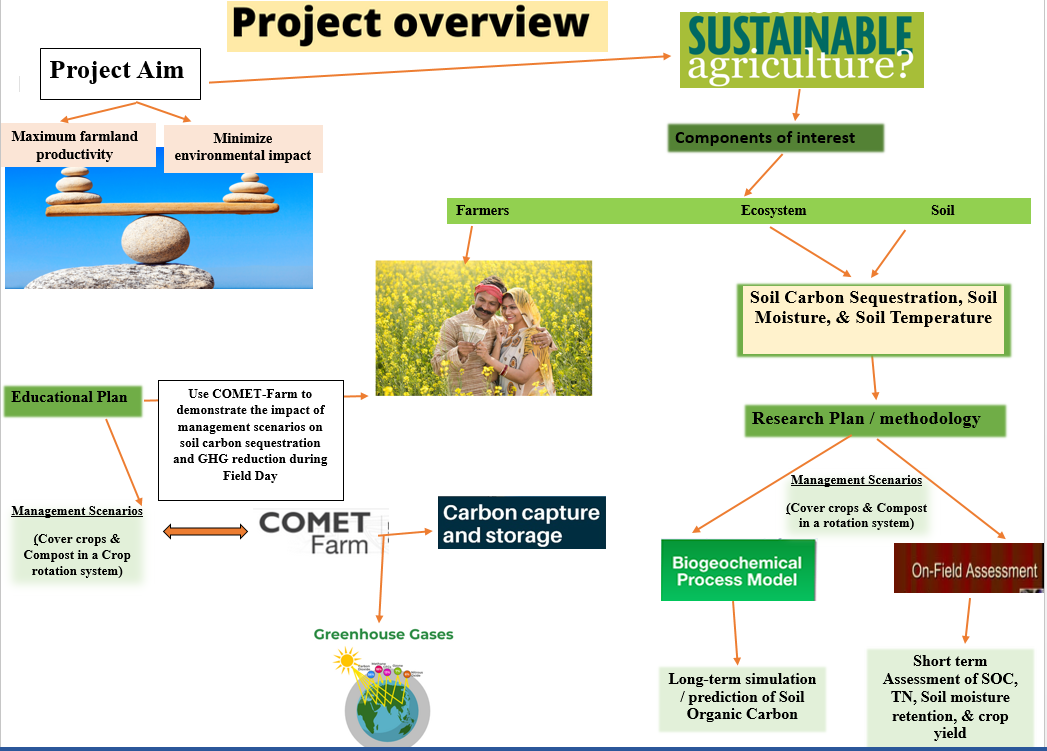Project Overview
Commodities
- Agronomic: canola, oats, peas (field, cowpeas), sorghum (sweet), wheat
Practices
- Crop Production: cover crops, cropping systems, crop rotation, fallow, fertigation, irrigation, no-till, water management
- Education and Training: demonstration, extension, participatory research, workshop
- Natural Resources/Environment: carbon sequestration, soil stabilization
- Soil Management: composting, nutrient mineralization, organic matter, soil analysis, soil quality/health
Proposal abstract:
Agriculture in semi-arid regions, such as the Southwestern United States, faces increasing challenges due to climate change and reduced water availability, threatening agricultural productivity, soil health, and farmers’ livelihoods. We aim to address these challenges by evaluating the impact of cover crops and compost on soil moisture dynamics and carbon sequestration in a winter wheat–sorghum–fallow rotation system. Additionally, the long-term carbon sequestration potential of these practices will be evaluated by using the DayCent model. The carbon (C) sequestration potential will be demonstrated to the farmers through COMET-Farm scenario analysis of how these management practices can enhance C storage and reduce greenhouse gas emissions.
Our project integrates field experimentation and advanced simulation modeling to comprehensively assess cover cropping and compost as Climate Smart Management Practices (CSMPs). Through field assessments, we will measure soil moisture, temperature, total nitrogen, and soil organic carbon over a two-year period (2025–2026), while the DayCent model will estimate long-term carbon sequestration potential for 2027–2080. This dual approach allows for a detailed analysis of the environmental and economic benefits of these practices. The findings from this research are expected to offer practical, science-backed solutions for farmers in semi-arid regions to enhance soil health, conserve water, and increase carbon sequestration.
Our outreach will include engaging local farmers, agricultural cooperatives, and policymakers through workshops, field demonstrations, and educational materials. Results will be shared via peer-reviewed publications, extension bulletins, and online platforms to ensure broad dissemination. By focusing on sustainable agricultural practices, this project contributes to a future where semi-arid farming systems are resilient, productive, and environmentally sustainable.
Project objectives from proposal:
Research Plan
- Investigate the effects of cover crops and compost on soil moisture and carbon sequestration in a sorghum-wheat rotation system by measuring SOC, TN, soil moisture, and temperature at different depths for two years.
- Estimate the long-term carbon sequestration potential by simulating compost and cover crop practices under future climate scenarios using the DayCent model (2027 – 2080).
Education/outreach Objectives
- To educate local growers about the application and benefits of Climate Smart Management Practices (CSMPs) for sustainable agriculture in the Southern Great Plains.
- To use COMET-Farm to demonstrate the impact of management scenarios on soil carbon sequestration and GHG reduction during Field Day
- To disseminate research findings to researchers, educators, potential agricultural investors, students, and policymakers.
